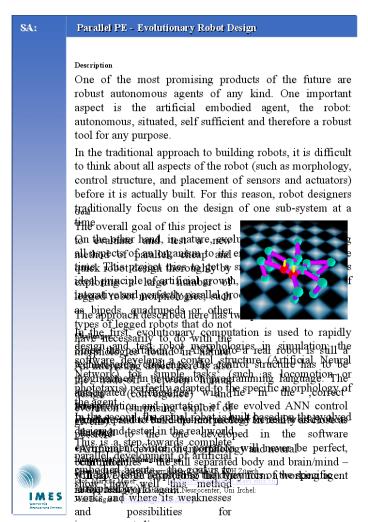SA Parallel PE - PowerPoint PPT Presentation
1 / 1
Title:
SA Parallel PE
Description:
In the traditional approach to building robots, it is difficult to think about ... tasks (such as locomotion or phototaxis) perfectly adapted to the specific ... – PowerPoint PPT presentation
Number of Views:53
Avg rating:3.0/5.0
Title: SA Parallel PE
1
Parallel PE - Evolutionary Robot Design
SA
Description
One of the most promising products of the future
are robust autonomous agents of any kind. One
important aspect is the artificial embodied
agent, the robot autonomous, situated, self
sufficient and therefore a robust tool for any
purpose. In the traditional approach to building
robots, it is difficult to think about all
aspects of the robot (such as morphology, control
structure, and placement of sensors and
actuators) before it is actually built. For this
reason, robot designers traditionally focus on
the design of one sub-system at a time. On the
other hand, in nature, evolution works by
adapting all aspects of an organism to its
environment at the same time. This project tries
to get a small step closer to this ideal
principle of artificial growth, the natural
principle of interative and perfectly parallel
product development. The approach described here
has two phases In the first, evolutionary
computation is used to rapidly design and test
robot morphologies in simulation the software
develops a control structure (Artificial Neural
Network) for simple tasks (such as locomotion
or phototaxis) perfectly adapted to the specific
morphology of the agent. In the second, the
actual robot is built based on the evolved design
and tested in the real world.
Goal
The overall goal of this project is to evaluate
and test a new method of parallel, cheap and
quick robot design thoroughly by exploring a
large number of legged robot morphologies, such
as bipeds, quadrupeds or other types of legged
robots that do not have necessarily to do with
the morphologies found in nature. An interesting
aspect here is also the trade-off between human
design (convergence) and evolution (surprising
exploit of givens). This is a step towards
complete parallel development of artificial
embodied agents the goal is to show how well
this method works and where its weaknesses and
possibilities for improvements lie.
Challenges
Since the portation of ANN into a real robot is
still a technological challenge, the control
structure has to be programmed in a common
programming language. The anticipated
difficulties will lie in the correct
interpretation and portation of the evolved ANN
control structure and to build the morphology in
reality as close as possible to the one developed
in the software environment. Since the portation
will never be perfect, both modules - the still
separated body and brain/mind will have to be
adjusted so that they form a working agent in the
real world again.
Topics
- Parallel product development method for real
world robots through - Artificial Coevolution (morphology and neural
controller) - Cheap Design (exploiting the dynamics of the
specific morphology)
Information and Administration
Zentrum für Produkte-Entwicklung, D-MAVT, ETH
Zürich Prof. Markus Meier markus.meier_at_imes.mavt
.ethz.ch Artificial Intelligence Laboratory,
Neurocenter, Uni Irchel Josh Bongard
bongard_at_ifi.unizh.ch































